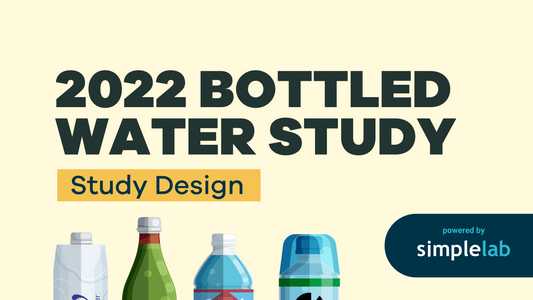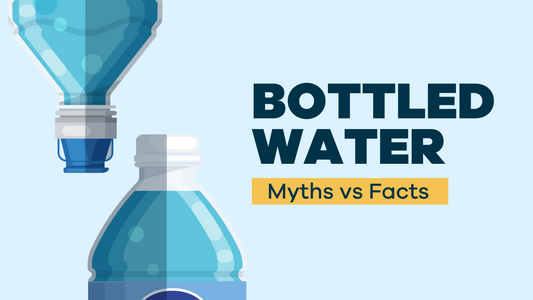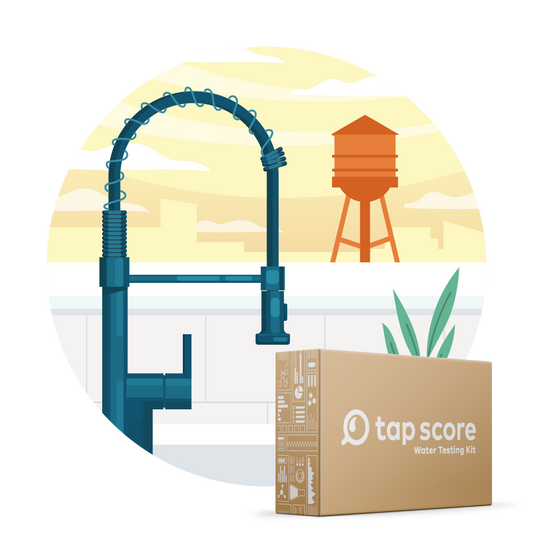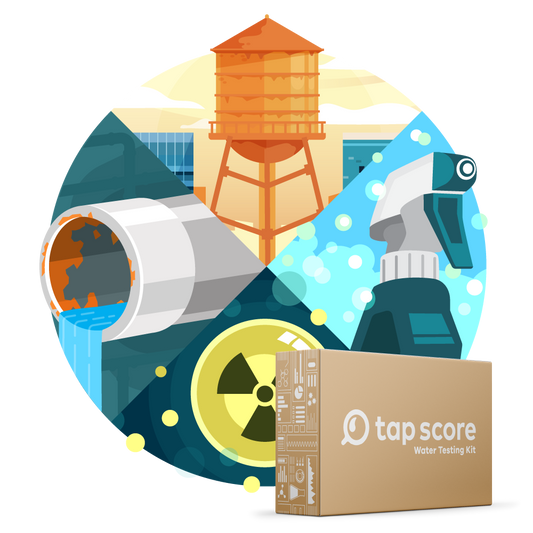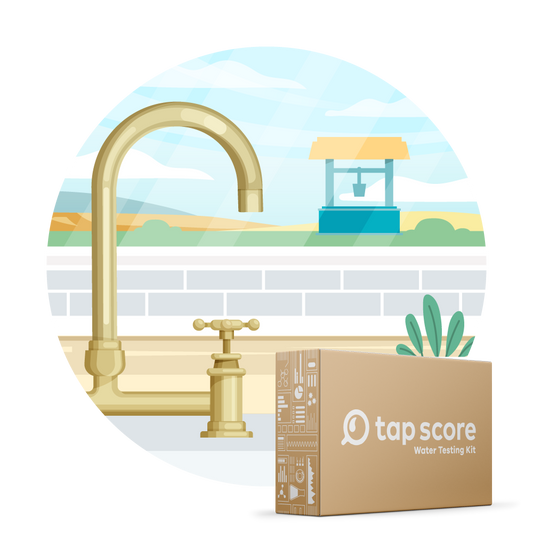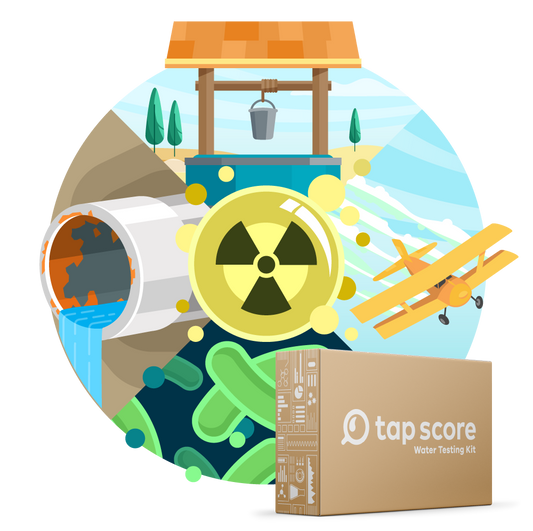
Bottled Water Study: Preliminary Results
In 2022, we embarked upon a large bottled water reconnaissance study in the California Bay Area that included both local and national brands (read a summary of the study design here). The final study will compare bottled water with the region’s tap water, but in this post we will focus on laboratory testing results for bottled water products only.
Study Design Summary
Bottled water products are differentiated by the FDA based on source and specific water quality characteristics. We selected specific products for our study based on the market share of products sold in the U.S. by category. The types of products we purchased included 46 purified products, 46 products derived directly from groundwater sources (including spring, mineral, artesian, and well products), and 8 products that do not meet regulatory requirements and are therefore referred to as unregulated in our study. Some purified products are sub-categorized as alkaline, and one purified product and many groundwater products are sub-categorized as sparkling. None of the products tested had added flavors.
For our study, accredited laboratories measured 103 analytes in 100 different bottled water products available around the Bay Area and evaluated them based on both their potential health and aesthetic impacts. We compared the concentrations of any measured contaminants with health-based benchmarks, where available. This allows us to understand water quality exposures in bottled water and their relative health impacts. And because the choice of bottled water over other sources of drinking water often hinges on people's aesthetic preferences, we also looked at how water quality in these products impacts the taste and odor of the water using aesthetic-based benchmarks.
Water quality information for bottled water is not required by law to be available and, even when companies voluntarily provide the information, consumers must often call a phone number or go to a website to find it with no guarantee that the data is current or complete.[1][2] The water quality of bottled water products can vary widely due to differences in water sources, treatment techniques, bottling procedures, etc. Preferences for bottled water over other drinking water sources (e.g., tap water) are often due to the perception that bottled water presents less of a health risk than other options, despite the fact that the true quality and health risk of bottled water is not clear.[3][4][5] Additionally, the perception of bottled water as being safer than other choices is often based on the aesthetic experience of the water, such as its taste and odor, which typically has no relationship with its potential health impacts.[4]
Summary of Results
Of the 103 analytes measured in the bottled water samples, 43 were detected in total across all 100 bottled water products. Twenty one of the detected analytes have known health impacts, and 17 were detected in exceedance of their health-based benchmarks across 53 samples. In addition, 17 of the detected analytes have known aesthetic impacts and 7 were detected in exceedance of their aesthetic-based benchmarks across 65 samples.
Benchmarks are briefly explained in the study design, but as a quick reminder: a health-based benchmark is the concentration of a contaminant above which adverse health impacts may occur if the water is consumed over a long period of time. These benchmarks are established by reputable public health agencies. Aesthetic-based benchmarks are similar in that they are set at the lowest concentrations at which a contaminant may impact the aesthetic experience of consuming the water, typically imparting a taste, odor or color to the water. These benchmarks are gathered from governmental, institutional and academic sources.
Let’s dig into these results, focusing on potential health impacts first, before shifting to potential aesthetic impacts.
Potential Health Impacts
Many contaminants detected in bottled water exceeded their health-based thresholds. Contaminants detected above their health-based threshold may cause adverse health impacts if the product is consumed as the primary source of drinking water on a long term basis. The plot below shows the percentage of samples in which contaminants were detected in exceedance of their health-based benchmarks.

Chloroform was detected above its health-based benchmark in 32 out of the 100 products, which was more than any other contaminant. Chloroform belongs to a family of contaminants called trihalomethanes (THMs). THMs are carcinogenic compounds that are formed when disinfectants (like chlorine) react with other compounds that are naturally present in the water. Bromodichloromethane, dibromochloromethane and bromoform are also trihalomethanes. Trihalomethanes make up the top three compounds that exceeded their health-based benchmarks, with bromoform not far behind at number six. The health-based benchmarks of all four compounds are below their respective detection limits—this means any detection results in an exceedance of the compound’s respective health-based benchmark.
At least one THM was detected, thereby exceeding its health-based benchmark, in 34 products. Of these products, the majority (27) were classified as purified, which is to be expected as these products are typically produced from municipal sources that have been chlorinated prior to entering the bottling plant. Four of the products were classified as unregulated so they aren’t subject to regulations and we don’t have information on their sources or treatment methods. Surprisingly, three of the products containing THMs were in our groundwater category, meaning that they come from groundwater sources that are not chlorinated prior to extraction. We didn’t expect the groundwater products to be chlorinated because they are typically marketed as “natural” and “pure”, and especially since maintaining a disinfectant residual is not mandated by regulations the way it is for tap water. None of these products had any information about treatment on their packaging and one had no information on the source of the water. All we can say about these products is that they were either chlorinated after extraction or the original sources included water that had been chlorinated prior to reaching the bottling plant.
The next class of compounds detected in exceedance of their health-based benchmarks was geogenic contaminants, or contaminants that occur naturally in the aquifer material that comes in contact with groundwater supplies. Arsenic, uranium, lithium and fluoride were detected above their health-based benchmarks in several bottled water products (benchmarks for arsenic and uranium are set at zero). All detections of arsenic, uranium and lithium exceeded their benchmarks and, as expected, occurred in products in the groundwater category. Fluoride, on the other hand, was detected in 22 products but only exceeded its benchmark in 2 samples. All of the products in which fluoride was detected were groundwater products with the exception of one purified product (that did not specify its source or treatment techniques on its packaging).
Metals were not detected above their health-based benchmarks very often, if at all. In tap water we expect metals to be present due to their release via corrosion of pipes and fixtures. However, bottled water is not exposed to a distribution system after extraction and/or treatment so we do not expect high levels of metals that typically come from pipe or fixture corrosion.
Potential Aesthetic Impacts
Many contaminants detected in bottled water exceeded their aesthetic-based thresholds, including pH which was outside of its ideal range in over half of the samples tested. When a contaminant exceeds its aesthetic-based threshold, it may impact the taste or odor of a bottled water product. The plot below is similar to the one above for health, but it shows the percentage of samples in which contaminants were detected in exceedance of their aesthetic-based benchmarks. This is an important aspect of the products to assess because a negative aesthetic experience is a common reason for people to choose bottled water over other drinking water options.

*TDS = total dissolved solids
pH was detected outside of its ideal range in a whopping 58 products—the recommended range for the pH of drinking water is 6.5 - 8.5 based on taste and mouthfeel. The pH values of the products we analyzed ranged from 4.0 to 10.4, but this wide range was expected. The lowest pH values were either measured in sparkling products, which contain high levels of carbon dioxide that partitions into the water over time and creates acidic conditions, or purified products that did not add minerals back after treatment (e.g., distilled products). On the other end of the spectrum, high pH levels were measured in purified products sub-categorized as alkaline. These products contain added minerals that increase the pH of the water. Judging by the popularity of both sparkling and alkaline products, our results suggest that people choose products that would typically be considered undesirable despite the aesthetic drawbacks, or the generally accepted range of desirable pH values is too restrictive.
The remaining analytes that exceeded their aesthetic-based benchmarks are all naturally occurring and were typically found at high concentrations in mineral water, a subset of our groundwater category that is differentiated in regulations due to the presence of high concentrations of various natural minerals. Typically, concentrations of these minerals in exceedance of their benchmarks would not be recommended as they could impart an unpleasant taste to products.
Other Detections
Another contaminant worth noting is total HPC, a measurement of heterotrophic bacteria that are detectable via a specific standard method. The group of bacteria detected using this method are not correlated with disease when consumed via drinking water and are therefore not considered a health risk (and do not have a health-based benchmark). Rather, total HPC is often used as an indicator of treatment efficacy and water quality changes during storage and distribution. [6] It is common for bottled water to have measurable total HPC concentrations and is not a direct cause for concern.
While we recognize that the bacteria measured via total HPC do not present a direct health risk, we think it’s important that people understand that bottled water is not necessarily sterile. We detected heterotrophic bacteria via total HPC in 58 out of 100 products. We did not detect total coliforms (including E. coli) in any of these samples, which would have been a potential health concern.
Preliminary Conclusions
Overall, it is clear that bottled water is not necessarily sterile or free of contaminants. We detected trihalomethanes at levels of potential concern in many products (mostly purified products, but a few in our groundwater category as well). Geogenic contaminants like arsenic, uranium, lithium and fluoride were also detected at potentially concerning concentrations in some groundwater products.
We also found various potential aesthetic concerns among the bottled water products we analyzed. The biggest offender was pH—the majority of samples we analyzed had pH values outside of the ideal range of 6.5 - 8.5 (many of which had intentionally elevated pHs). There were also levels of naturally occuring minerals in some products that have the potential to impart an unpleasant taste to the water.
There were also many contaminants that we did not find, or found very rarely, in the bottled water samples. We did not detect coliform bacteria, including E. coli, in any of the samples. In addition, metals that are typically derived from the corrosion of pipes and fixtures were rarely detected or not detected at all. Lead and cobalt were detected in a single sample each, and other metals common in tap water, including nickel and copper, were not detected at all.
Read More
▾Sources and References
▾- Federal Code of Regulations Title 21; Vol. 21 CFR §165.110.
- Leiba, N.; Gray, S.; Houlihan, J. 2011 Bottled Water Scorecard; Environmental Working Group, 2011. http://www.ewg.org/bottled-water-2011-home
- Doria, M. F. Bottled Water versus Tap Water: Understanding Consumers’ Preferences. J. Water Health 2006, 4 (2), 271–276. https://doi.org/10.2166/wh.2006.0023
- Doria, M. F. Factors Influencing Public Perception of Drinking Water Quality. Water Policy 2009, 12 (1), 1–19. https://doi.org/10.2166/wp.2009.051
- Hu, Z.; Morton, L. W.; Mahler, R. L. Bottled Water: United States Consumers and Their Perceptions of Water Quality. Int. J. Environ. Res. Public. Health 2011, 8 (2), 565–578. https://doi.org/10.3390/ijerph8020565
- Allen, M. J.; Edberg, S. C.; Reasoner, D. J. Heterotrophic Plate Count Bacteria—What Is Their Significance in Drinking Water? Int. J. Food Microbiol. 2004, 92 (3), 265–274. https://doi.org/10.1016/j.ijfoodmicro.2003.08.017


